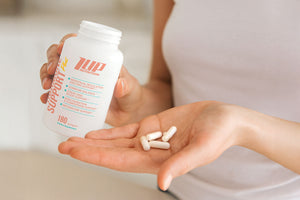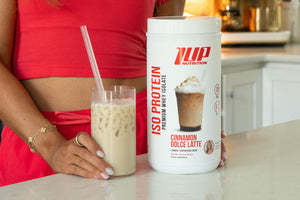We all know that fiber is an important part of a healthy diet. What you might not realize is that fiber is an unsung hero of fat loss too! In fact, research shows that individuals with higher intakes of fiber have a lower risk of having belly fat.[1]
How does fiber help support weight loss and maintain a lean physique?
We’ll answer that question (and more), and we’ll even give you our top 5 high-fiber food picks.
But, before we get there, let’s briefly talk about what fiber is and what purpose it serves in our diets.
What is Fiber?
Fiber is the indigestible portion of carbohydrates contained in plant foods, such as fruits, vegetables, and whole grains.
While our bodies cannot digest fiber, it still serves several important roles in the body. We’ll cover those more in a second, but first, it’s worth mentioning that there are two main types of fiber:
-
Soluble fiber -- dissolves in water and forms a thick “gel” that helps slow digestion, which in turn helps increase feelings of fullness. Examples of soluble fiber include oat bran, pectin, and guar gum.
- Insoluble fiber -- doesn’t dissolve in water and mainly acts as a “bulking agent” for stool and also helps move it through your gut. Examples of insoluble fiber include cellulose and lignins which are typically found in leafy greens and beans.
How Does Fiber Help Boost Weight Loss?
As we mentioned above, studies have shown a strong link between higher fiber intakes and slimmer waistlines.[6] In fact, some research has even shown that increasing your daily intake of soluble fiber may help lose belly fat as one study noted that for every 10 grams of soluble fiber intake, individuals had a 3.7% lower risk of gaining weight.[1]
The problem is that the vast majority of Americans don’t even get half of their recommended intake of dietary fiber each day![3,4]
FYI, general recommendations for fiber intake for adults, per the latest Dietary Guidelines, is between 25-38 grams per day (or roughly 14 grams of fiber per 1000 calories of food eaten).[3,4]
Besides weight loss, other studies note that individuals with higher fiber intakes also tend to have significantly lower rates of several major chronic diseases[5], including:
- Type 2 diabetes
- Obesity
- Hypertension (high blood pressure)
- Stroke
- Hyperlipidemia (high cholesterol)
- Cardiovascular disease
- Digestive disorders
Simply put, fiber plays a pretty big role in not only promoting a healthy body composition but also your overall health and wellness.
So, what is it about fiber that does a body good?
Well, for starters, fiber...
Reduces Hunger
When we eat foods high in soluble fiber, it attracts water and adds volume to bulk food in your GI tract which slows digestion and helps you feel fuller for longer. Due to these increased feelings of satiety, you can eat fewer calories while still feeling full, and you’re less likely to overeat at mealtime or go snacking in between meals, both of which derail your dieting efforts.
Low in Calories
Foods high in fiber also tend to be lower in calories than foods with little to no fiber. Part of this is due to the fact that insoluble fiber is indigestible by the human body, which means we do not derive any energy (calories) from it.
Supports Stable Blood Sugar Levels
In addition to delaying stomach emptying (which increases satiety), soluble fiber can also regulate blood sugar levels.[7]
More stable blood sugar levels help defend against the development of insulin resistance or diabetes. And, as an added bonus, since your body isn’t subjected to wild swings in insulin and blood glucose levels, energy levels are stable, hunger levels are kept in check, and you’re able to avoid cravings more effectively.
Promotes a Healthy Gut
Fiber also serves as food for the good bacteria in your gut.[8]
A special type of soluble fiber known as fermentable fiber is digested by these bacteria, which they use to produce short-chain fatty acids (such as butyrate) which serves as the primary energy source for the cells lining your colon, thereby serving an important role in colon health.[9]
When your gut bacteria don’t get enough food, they slowly die off (much like any other organism that is deprived of food). When this happens, we become more susceptible to infection, illness, and disease.
And, to top it off, recent research indicates that individuals with greater gut bacteria diversity have a decreased risk of belly fat.[10]
Top 5 High-Fiber Foods for Weight Loss
Beans
Beans, beans, they’re good for the heart. The more you eat….
We’ve all heard that timeless song, and there’s much truth to it, as well.
Beans are really a superfood in the nutrition world, as they’re not only packed with essential vitamins and minerals but lots and lots of fiber.
In fact, one cup of cooked beans can contain between 10-15 grams of fiber (depending on the type of bean)![11]
Beans are great tossed into salads and soups or mashed into a paste for a delicious dip or sandwich spread.
Oat Bran
Oat bran is the outer shell of the oat groat. It’s low in cholesterol and higher in soluble fiber than many other fruits and vegetables, including broccoli, blueberries, and almonds. In fact, just one ounce (28 grams) of dried oat bran contains 12 grams of belly-filling fiber!
Oat bran is rich in a type of soluble fiber called beta-glucans, which has been noted in some research to help reduce cholesterol and blood pressure.[12]
Cauliflower
Cauliflower is quite the versatile veggie. Besides the fact that it can be cut into florets and roasted to golden brown perfection, cauliflower can also serve as the ideal fill in for low-carb rice-based dishes (like jambalaya) or even mashed potatoes -- the ultimate comfort food. Cauliflower can even be sliced into “steaks” and grilled on the BBQ for a healthy, hearty vegan or vegetarian dinner!
The best part is that cauliflower is high in fiber, very low in calories, and incredibly filling.
Raspberries
We all get a craving for something sweet from time to time, and in order to satisfy our sweet tooth, we usually grab something very high in added sugar, fat, and calories and low in fiber.
But what if you could enjoy something that both satisfies your craving for something sweet while also delivering a knockout nutritional punch?
Enter berries.
Berries as a class of fruits are really in a league of their own. They’re packed full of vitamins, minerals, and fiber. They’re also low in calories and taste absolutely delicious.
We’re partial to raspberries as each cup of the red berries has an impressive eight grams of dietary fiber while only containing around 65 calories!
1UP Fiber + Vitamin C + Probiotics
1UP Fiber + Vitamin C + Probiotics supplies EIGHT grams of fiber per serving split between five grams soluble fiber and three grams insoluble fiber from a mixture of three all-natural sources including:
- Psyllium Husk
- Inulin
- Golden flaxseed
For the probiotics portion of 1UP Fiber + Vitamin C + Probiotic, we’ve included 3 billion heat-stable bacillus coagulans. Bacillus coagulans are a type of good gut bacteria commonly used to promote gut health and combat GI distress due to the fact that it exhibits properties of both the Bacillus and Lactobacillus genera -- two of the most commonly supplemented bacteria for gut health.[1]
And, as an added bonus, 1UP Fiber Plus also supplies 370mg of plant-based omega-3 fatty acids (as ALA) from the flax seed.
Add a thermogenic fat burner (HIS or HER formula) to the mix for ultimate results
Fat Burner will help you burn more calories, control appetite, and give you more energy and focus throughout the day. Remember, your diet must be on point. You cannot go over your daily calories because the extra calories will override the burned calories from this product and weight loss benefits will diminish. MAIN BENEFITS · Promotes Weight Loss · Promotes Energy · Promotes Mood and Focus · Promotes Appetite Control
References
- Hairston KG, Vitolins MZ, Norris JM, Anderson AM, Hanley AJ, Wagenknecht LE. Lifestyle factors and 5-year abdominal fat accumulation in a minority cohort: the IRAS Family Study. Obesity (Silver Spring). 2012;20(2):421–427. doi:10.1038/oby.2011.171
- Konuray G, Erginkaya Z. Potential Use of Bacillus coagulans in the Food Industry. Foods. 2018;7(6):92. Published 2018 Jun 13. doi:10.3390/foods7060092
- King, D. E., Mainous, A. G. 3rd, & Lambourne, C. A. (2012). Trends in dietary fiber intake in the United States, 1999-2008. Journal of the Academy of Nutrition and Dietetics, 112(5), 642–648. https://doi.org/10.1016/j.jand.2012.01.019
- "Appendix 7. Nutritional Goals for Age-Sex Groups Based on Dietary Reference Intakes and Dietary Guidelines Recommendations - 2015-2020 Dietary Guidelines." Home of the Office of Disease Prevention and Health Promotion - Health.gov.
- National Research Council (US) Committee on Diet and Health. Diet and Health: Implications for Reducing Chronic Disease Risk. Washington (DC): National Academies Press (US); 1989. 10, Dietary Fiber.
- Shay CM, Van Horn L, Stamler J, et al. Food and nutrient intakes and their associations with lower BMI in middle-aged US adults: the International Study of Macro-/Micronutrients and Blood Pressure (INTERMAP). Am J Clin Nutr. 2012;96(3):483–491. doi:10.3945/ajcn.111.025056
- Riccardi, G., & Rivellese, A. A. (1991). Effects of dietary fiber and carbohydrate on glucose and lipoprotein metabolism in diabetic patients. Diabetes Care, 14(12), 1115–1125. https://doi.org/10.2337/diacare.14.12.1115
- McGill CR, Fulgoni VL 3rd, Devareddy L. Ten-year trends in fiber and whole grain intakes and food sources for the United States population: National Health and Nutrition Examination Survey 2001-2010. Nutrients. 2015;7(2):1119–1130. Published 2015 Feb 9. doi:10.3390/nu7021119
- Wong, J. M. W., de Souza, R., Kendall, C. W. C., Emam, A., & Jenkins, D. J. A. (2006). Colonic health: fermentation and short chain fatty acids. Journal of Clinical Gastroenterology, 40(3), 235–243.
- Beaumont M, Goodrich JK, Jackson MA, et al. Heritable components of the human fecal microbiome are associated with visceral fat. Genome Biol. 2016;17(1):189. Published 2016 Sep 26. doi:10.1186/s13059-016-1052-7
- USDA National Nutrient Database for Standard Reference, Legacy Release. U.S. Department of Agriculture, Agricultural Research Service. https://ndb.nal.usda.gov. Accessed Nov. 7, 2018
- Maki, K. C., Galant, R., Samuel, P., Tesser, J., Witchger, M. S., Ribaya-Mercado, J. D., Geohas, J. (2007). Effects of consuming foods containing oat beta-glucan on blood pressure, carbohydrate metabolism and biomarkers of oxidative stress in men and women with elevated blood pressure. European Journal of Clinical Nutrition, 61(6), 786–795. https://doi.org/10.1038/sj.ejcn.1602562






